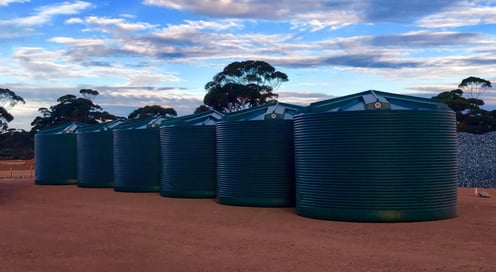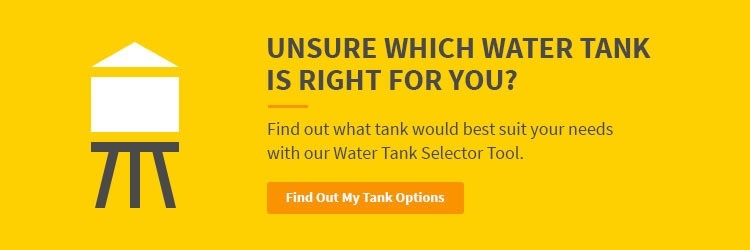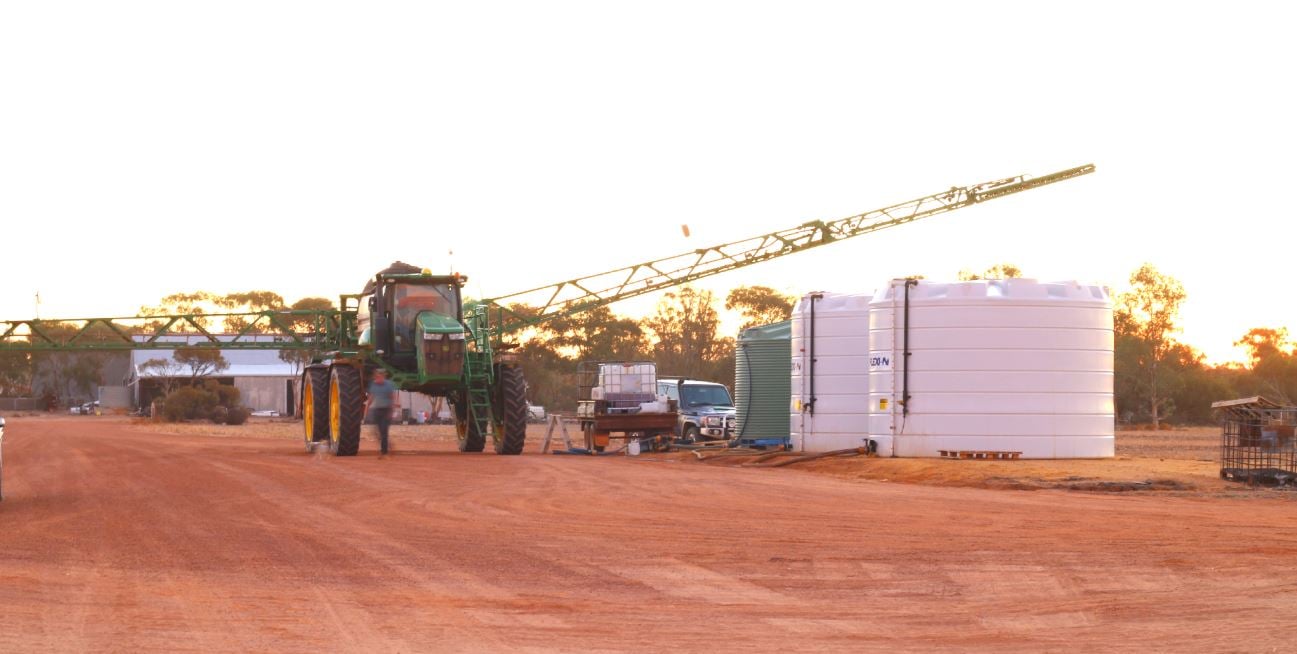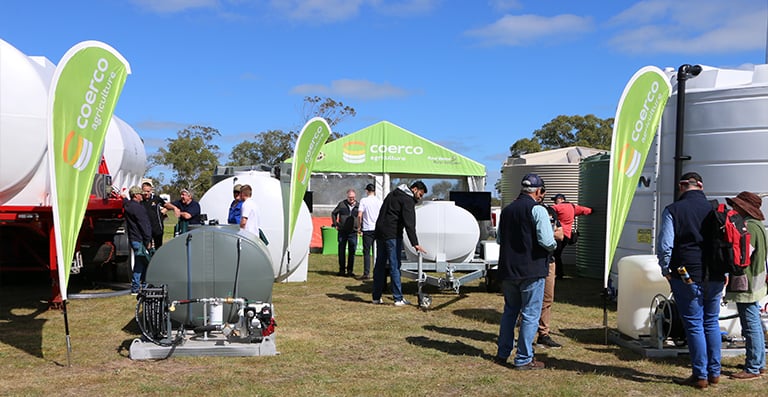It comes as no surprise that many people want to know about the price of water tanks. After all, water conservation and management are always going to be a fundamental need to allow Australian agriculture to exist.
Couple this with the inconsistent rainfall in Australia and issues with the reliability of water sources, it’s clear that rural properties and farms must acquire and install rainwater tanks to ensure their programs remain operational and grow to be efficient. Finding a water tank that’s a perfect fit pricewise and quality-wise only makes sense.
So, how much is a water tank?
There are a range of factors that can affect water tank costs. This article will provide you with the information you need prior to purchase and help you understand the elements that drive water tank prices up or down so you can be confident of your purchase.
The topics that will be covered here are:
I. Factors that keep the price of water tanks either up or down:
II. Factors that keep the price of water tanks up
III. Factors that keep the price of water tanks down
IV. Company Philosophy on Pricing
V. Water Tanks Price Comparison
VI. Warranty
VII. Get started. Get a quote.
I. Factors That Keep the Price of Water Tanks Either Up or Down
1. Size Affecting the Cost of Water Tanks
In general, it goes without saying that a smaller tank size made of the same material and from the same manufacturer will be cheaper than a bigger tank from the same range.
However, keep in mind that buying a 50,000-litre water tank doesn’t necessarily mean
you will pay an amount equivalent to five 10,000 litre water tanks.
Your ideal water tank size can be determined by the following:
- Potential Rainwater Collection
- Average Household Water Requirements
- Farm Water Requirements (either stock water or water for crop spraying)
The topics above have been covered more in-depth and moved to this related topic below:
11 Questions to Ask Before Purchasing and Installing Poly Water Tanks
2. Material Affecting the Cost of Water Tanks
The most common materials used in the production of water tanks are polyethylene (poly), fibreglass, concrete, and steel/metal. Each material has their unique physical properties which determines how they are treated in manufacturing (among other things), and thus, influences price.
This table outlines major areas that are impacted due to the material:
|
Material |
Poly |
Fibreglass |
Concrete |
Steel/Metal |
|
Manufacturing Process |
Automated process for consistent results. One-piece. | Labour intensive, with parts prepared individually and then attached together | Labour intensive, requiring concrete, reinforcing mesh and steel formwork. | Labour intensive. Multiple panels require passing through different machines. |
|
Protective Coatings |
UV-stabilised & food-grade without a need for coatings. | Internal food-grade coating and external gelcoat. | No coating but care must be taken to avoid rust due to reinforcing mesh, etc. | Galvanised: Zinc coating + food-grade polyethylene liner. Stainless: layer of chromium. More expensive than galvanised. |
|
Delivery |
Lightweight. Easily loaded up on truck. Great resistance to damage during transport. | Lightweight. Care must be observed during transport to prevent cracks. | Pre-made concrete tanks: Heavy and challenging to transport. | Various parts need to be transported requiring time and multiple people. |
|
Installation |
Fast and easy. No heavy machinery needed. | No need for heavy machinery but more care should be given during installation. | Pre-made: requires heavy-duty machinery. Poured onsite: takes more time to finish. Earthmoving for concrete underground water tanks add to price. |
Requires panels to be positioned and joined together on site. Takes more time to finish. |
Factors such as labour-intensive manufacturing processes, the need for protective coatings/liners, challenging deliveries, and lengthy installations, all add up to the cost you pay to get the tank.
Note that each water tank material mentioned above works. Your decision will depend largely on your preference and/or what best suits the specific use that you have in mind.
Related topics:
Why Rotational Moulding of Poly Water Tanks is a Big Deal
What Do I Need to Do For Tank Pad Preparation?
Water Tank Installation Cost and Preparation to Take Note Of
3. Fittings / Accessories Affecting the Cost of Water Tanks
Features in water tanks that help simplify usage include inlet and outlet pipes, discharge nozzles, liquid level indicators, and other accessories.
Sometimes, a standard fit water tank may not be the best solution for your specific situation. Adjustments or additional fittings/accessories as well as plumbing add to cost.
Add-on accessories depending on range of usage:
- Inlet and outlet pipes
- Gutter and downpipe installation
- Pressure pump
- Water filtration
- First flush diverter
Related topic:
Every Must-Have Component for Rainwater Harvesting You Should Be Familiar With
4. Maintenance Affecting the Cost of Water Tanks
The money you spend for maintenance and/or repairs may be separate from the money you spend during the buying process but is equally important.
Water tank maintenance is necessary to ensure that your stored water remains in top condition. For example, the accumulation of sludge or dirt compromises water quality and must be addressed.
Related topic:
Cleaning Sludge Out of Your Water Tank
The ease of maintenance also has to do with the water tank material. For example, one of the most critical complications in water tanks is corrosion because it affects water quality and speeds up your water tank’s degradation process. Hence, the more rust-resistant your water tank is, the less time and money you need to spend getting rid of the problem.
Besides rust, there are other issues that can make a water tank more high maintenance than others.
Find out more in this article:
Key Differences You Need to Know About Water Tanks
II. Factors That Keep the Price of Water Tanks Up
These factors are reliability indicators. If you’re looking for the best value for your money, these are the advantages you should look for.
1. Quality
Quality products can have higher prices because their manufacturer is committed to consistency, their brand, and their customers for the long haul. The value you get from quality is reliable and extended performance, allowing you to avoid constant and costly repairs, subpar performance, and poor manufacturer support.
here are many aspects about a company and its production practices that culminate in high-quality tanks which you’ll discover as you read further.
2. Brand name
Oftentimes, poor quality goods can outwardly mimic the signals of higher quality products. There may be companies that claim high-quality to justify high price but are, in fact, fly-by-night companies. This is where trust in a brand name comes in.
A well-established brand name may have higher prices due to well-founded reasons (see Company Philosophy on Pricing further below). Moreover, an established brand conveys trust. It operates on commitment to innovation that parallels its long-term commitment to customers.
3. Longer Warranty
Longer warranties are usually associated with higher quality products and greater accountability. Thus, the assurance of a longer warranty is added into the price of the final product. Cheaper brands that don’t offer much in the way of warranty may only want to get rid of their products as quickly as possible while steering clear of accountability.
Reminder: A warranty is only as good as the company behind it.
4. Certifications / accreditations
Certified storage tanks will be pricier than its non-certified counterparts. Being certified equates to better processes that meet the required standards for safety and quality.
Related topic:
Australian Standards for Reliable Poly Water Tanks
III. Factors That Keep the Price of Water Tanks Down
1. Shorter lead times
If quality is your priority, then a shorter lead time is an advantage.
Longer lead times usually translate to excessive costs for the company, which results in higher priced products. In contrast, shorter lead times are more streamlined and benefits the company, allowing them to create cost-effective products for you to enjoy.
2. Lesser quality raw materials (equates to no certifications)
Poor quality raw materials most likely lack certifications and are poor in quality. You may be able to find the cheapest water tank in its category, but constant repairs, eventual replacement, and resulting delays are expensive! As an aside, short lead times (discussed above) doesn’t necessarily mean using poor quality raw materials.
You have every right to pay attention to the price, but don’t forget to study the quality of the product as well.
3. Lesser years of experience in the industry
With experience comes deep knowledge and insight which should influence production. If a company has lesser experience in the industry, then it’s possible that they might not have the best practices around. This equates to lesser quality tanks that may be sold for a lower price.
Of course, take care not to get tricked by the illusion of a high price low quality combo.
IV. Company Philosophy on Pricing
At Coerco, we place great emphasis on reliability. Thus, we aim to create the right balance between the different elements that affect price in order to reach our ultimate goal: the manufacture and design of poly water tanks that benefit rural farmers for years to come.
Coerco is an established poly manufacturing company with the following qualifications:
- Coerco has the largest range of innovative poly products for agricultural use.
- Significant accreditations for product longevity
(standard guidelines in place and ISO 9001:2015 certified). - Greater independence in manufacturing processes to ensure consistent products across the board.
- Decades of experience and time well invested in research and innovation for the development of products you can trust.
- Short lead times (including production time, quick order processing and fast delivery).
- Being a country-based company with country-born key employees, we have a deep understanding of rural agriculture and use our insights to serve the rural community.
All the above reveals a deeply committed company dedicated to their brand and their customers for the long haul.
V. Water Tanks Price Comparison
Estimated Starting Price
|
Size in Litre |
Stainless Steel (Round) |
Stainless Steel (Slimline) |
Fibreglass |
Precast Concrete |
Poly (Slimline) |
Poly (Round) |
|
5,300 |
$2,200 |
$4,000 |
$1,400 |
$3,000 |
$2,000 |
$1,200 - $1,500 |
|
10,500 |
$3,600 |
$8,000 |
$2,200 |
$4,000 |
$4,000 |
$2,200 |
|
22,500 |
$5,000 |
$16,000 |
$3,200 |
$7,000 |
$8,000 |
$2,800 |
These prices are merely an estimate. Actual prices may deviate since there are many factors that affect the price of water tanks in each company. Cost can also vary according to state.
VI. Warranty
Claiming your warranty can be a stressful process when you’re unsure of the manufacturer’s reliability. Good thing Coerco is an ISO 9001:2015 accredited company.
Our passion for producing innovative products matches our friendly after-sales support. So, you can rely on being heard whenever you call regarding your warranty.
| Coerco Water Tank | Warranty |
| Premium Corrugated Tanks | 20 |
| Premium Flat Walled Tanks | 20 |
| Slimline Tanks | 10 |
See a complete list of Coerco products and their warranty here:
OUR PROMISE – Warranty Guarantee
VII. Get Started. Get a Quote.

Here are easy ways to get started today.
Click below to get in touch with our tank experts:
Contact Us
Click here for a FREE download of our catalogue:
Agriculture Catalogue
Click below to find out about any ongoing water tank promo:
Best Poly Tank Sale
Or try our water tank selector tool below!










What do you think about this post?
Comments